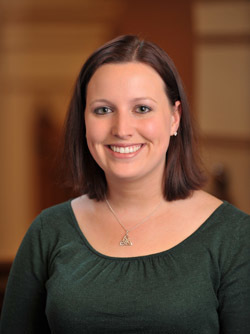
Megan McCullough, now a second- year Notre Dame civil engineering graduate student, counts her visit to Thailand after the December 2004 Indian Ocean tsunami as a turning point in her life. Then a rising senior in Notre Dame’s undergraduate engineering program, McCullough recalls her emotions on witnessing the physical and emotional fallout of this awful event: “Over 225,000 people were killed and countless others left homeless. To see first hand the effects of this disaster—still devastating, a full two years afterwards—was absolutely the most sobering moment of my life.” She resolved then to go to graduate school and equip herself with the tools “to make a difference in the world.”
McCullough is now working daily to develop techniques that will lessen the effects of future natural disasters—for both commercial and residential structures. Her research is in the cutting-edge area of multihazard civil engineering. “Instead of focusing on just one hazard—for example, wind—my work involves making coastal structures better able to withstand multiple hazards—earthquakes, wind, storm surge, or tsunami. Although the loads from each hazard are often different, a well-designed structure can respond well in many situations. Once we determine how structures are better able to survive these multiple stressors, the goal is to incorporate this knowledge into building codes as well as to help people in developing coastal areas build simple but stronger residential structures.”
McCullough’s work at Notre Dame is directed by Prof. Ahsan Kareem, the Robert M. Moran Professor in the Department of Civil Engineering and Geological Sciences and director of the NatHaz (Natural Hazards) Modeling Laboratory . Kareem created the laboratory facility in 2000 to both quantify the load effects on structures caused by such natural hazards as winds, waves, and earthquakes and then develop strategies to manage those effects. The NatHaz facility is operated in tandem with the Atmospheric Wind Tunnel at the Hessert Center for Aerospace Research.
At NatHaz, researchers like McCullough work both with computer simulations and laboratory experiments to better understand and predict the impact of natural hazards on the constructed environment. It is a second home to McCullough, who counts Prof. Kareem and Prof. Tracy Kijewski-Correa, a Double Domer, as two “amazing” mentors. “They have given me so many academic and professional development opportunities. I’ve been able to design my own Ph.D. project rather than have one handed to me. And, they have facilitated my attendance at several important conferences.”
McCullough counts her fellow graduate students as important components in her success. “I had the opportunity to attend other graduate schools but chose to continue on at Notre Dame. This university is special. Students here are collegial, not cutthroat. We work together to solve problems.”
McCullough recounts the words of Prof. Kijewski-Correa when she contemplates her role in devising solutions to the monumental problems of multihazard engineering: “People think that doctors are the ones to save lives, but engineers can save lives, too—by building infrastructures that keep people safe.”
More on Megan McCullough: Meet a Clare Booth Luce Fellow